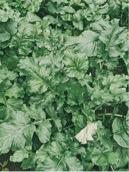Arugula
-
Scientific NameEruca vesicaria ssp. sativa
-
General InformationArugula ("rocket") is a spicy mustard green that is fast and easy to grow. There are two varieties: wild Italian arugula (Eruca selvatica) and common arugula (Eruca vesicaria ssp. sativa). Wild Italian arugula has delicate, peppery foliage and blossoms and small nutty leaves that make it more suited to salads than cooking. It is more heat resistant than common arugula.
 Photo: Wen Liu, unsplash
Photo: Wen Liu, unsplash -
When to Plant
Direct seed in the early spring, February through March and into May in cooler climates. In the fall, direct seed September through October.
Transplant: Arugula does best when direct seeded but if conditions demand, start seeds indoors in February to transplant four weeks later.
Plants prefer cool temperatures, so transplants will perform best when planted in early spring. Plants will withstand light frost
-
Planting
Neither type of arugula transplants well. Sow seeds directly in the ground in rows 12 inches apart. Thin plants in the rows to six inches apart. Cover with one-quarter to a half-inch of soil and keep the patch damp through the growing cycle. To deter birds and slugs, consider using row covers. Germinates in about 10 days and is ready for harvest in about five weeks.
Make new plantings every other week for a continuous supply. Do this until the temperatures get too hot or until about a month before the average first frost date.
Arugula needs full sun for best growth though, like most leafy greens, it will tolerate some shade and prefers some shade in warmer weather.
-
Soil Requirements
Arugula grows in a wide range of soil types. Loose fertile loam is best. Soil should have enough organic material to provide good water holding capacity and good internal drainage Prefers a soil pH of 6.0 to 7.0.
-
Water Requirements
Arugula is a high-water user and requires a uniform supply of water for tender growth. Frequent irrigation is preferred because of shallow rooting. A total of eight to 12 inches of water may be necessary during the growing cycle, depending on seasonal temperatures, rainfall, variety, and planting date.
Soil type does not affect the amount of total water needed, but does dictate frequency of water application. Lighter soils need more frequent water applications, but less water applied per application.
-
Fertilizing
Arugula needs quite a bit of nitrogen and slightly less phosphorus and potassium. Add two inches of compost to the soil and, if indicated by a soil test, add other amendments as necessary. Alternatively, prior to planting, amend soil with an organic, premixed planting blend. Follow directions on the package.
-
Pollination
Arugula is self-pollinating, but different varieties can cross-pollinate via insects.
If a few plants are let to go to seed, arugula will re-sow.
-
Harvesting
Italian arugula is ready to harvest in six to seven weeks. Common arugula is ready to harvest in about five to six weeks. Pick outer leaves regularly to keep the plant producing until it starts to flower. Younger plants have milder tasting leaves. Alternatively, the whole plant may be harvested by cutting at the soil line.
-
Storage
Arugula is best when harvested immediately before use. It will keep for up to a week when stored in the crisper drawer of the refrigerator with high relative humidity. Wash and drain before storing.
-
Good Varieties for Marin
‘Roquette' or ‘rocket’ is especially good for salads. It is frost hardy and grows 12 to 18 inches tall before bolting (flowering). When weather begins to warm, let some plants flower and self-sow to assure a future crop.
‘Astro’ is heat tolerant and has a slightly milder flavor.
‘Dragon’s Tongue’ is a beautiful variety. Its leaves are deeply lobed and a striking deep green with red veins. It is also frost hardy and reportedly not bitter even when it approaches 18 inches in height.
Wasabi arugula (Diplotaxis erucoides) forms pretty, leafy rosettes that have the spicy, startling flavor of horseradish. Its little flower stalks and dainty white blossoms are a special spicy delicacy. Add them to salads, sushi, and pasta dishes. They make a memorable and surprising garnish.
-
Helpful Tips
Unpleasantly pungent and bitter leaves are usually the result of hot weather and/or lack of water.
Slow bolting by reducing heat and moisture stress. Provide some shade for warm-season plantings.
Use arugula flowers for salads and to keep seed heads from forming.
-
Common Problems
Leaf miners are an occasional problem. Learn more.
-
Pests- Diseases & MoreN / A

